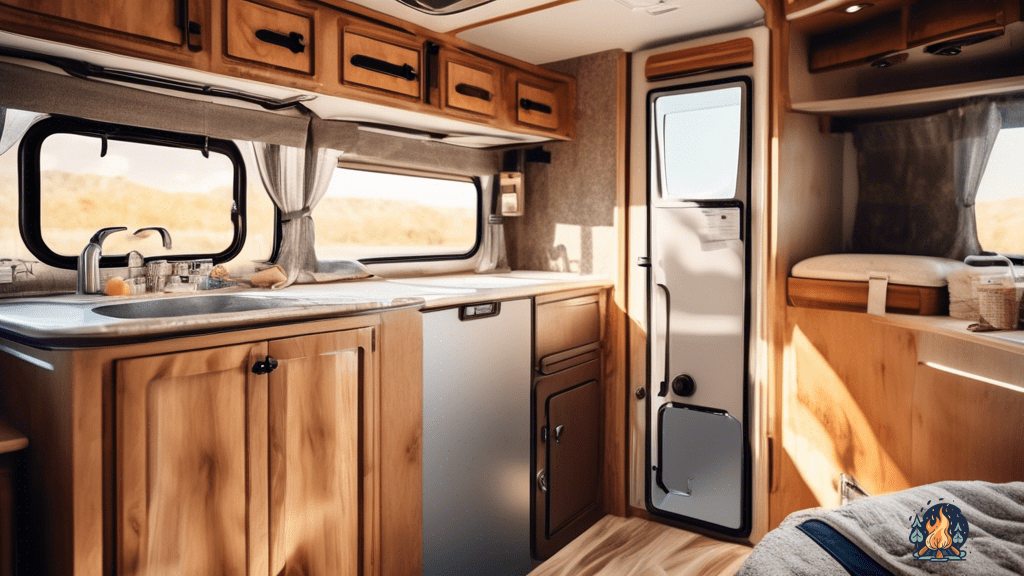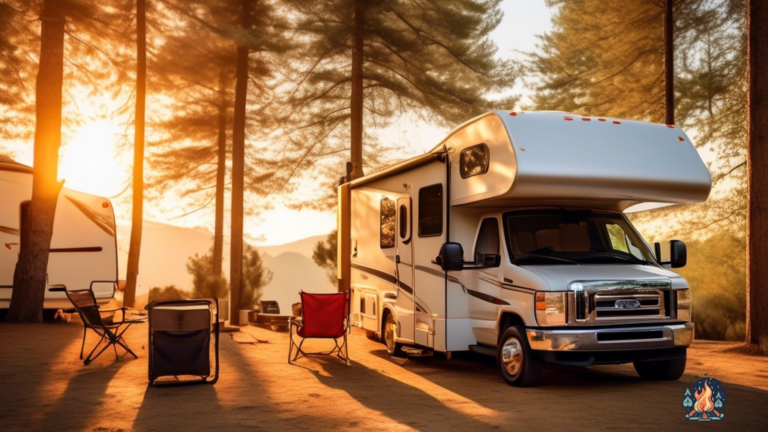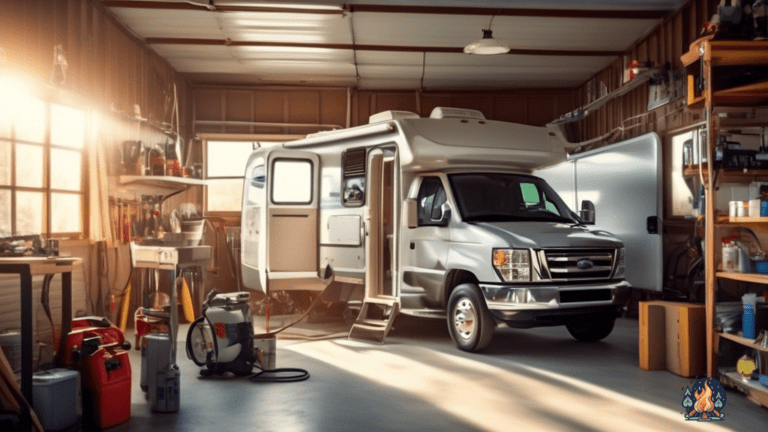Maintaining Your RV Water Heater: Tips And Tricks
by Kevin Fairbanks • Updated: January 21, 2024
Keep your RV water heater in peak condition with these expert maintenance tips and tricks. Click here to maximize your adventures on the road!

Are you ready to take on the exciting world of RV adventures? Well, before you hit the road, there’s one important aspect of your RV that you shouldn’t overlook – your water heater!
Maintaining your RV water heater is crucial to ensure a comfortable and enjoyable journey. In this article, we’ll share with you some valuable tips and tricks to keep your water heater in tip-top shape, so you can relax and unwind after a long day of exploring.
First things first, let’s talk about flushing and cleaning the tank regularly. Just like any other appliance, your RV water heater can accumulate sediment and mineral deposits over time. This can not only affect the performance of your water heater but also lead to unpleasant odors and taste in your water. To avoid this, make sure to flush and clean your tank at least once a year.
It’s a simple process that involves draining the tank, removing any accumulated debris, and flushing it out with fresh water. Trust us, a clean tank means fresh and delicious water for your showers and morning coffee – a true luxury on the road!
So, grab your cleaning gloves and get ready to show that water heater who’s boss!
Key Takeaways
- Winterizing your RV water heater is essential to protect it from cold weather.
- The process involves draining and flushing the water system to remove any excess water.
- Using antifreeze is crucial to prevent any damage to the water heater during the offseason.
- Proper maintenance gives you peace of mind and ensures the longevity of your RV water heater. Additionally, it impresses other campers with your attention to detail.
Flushing and Cleaning the Tank Regularly
Now that you know the importance of regularly flushing and cleaning your RV water heater, it’s time to roll up your sleeves and get down to business. Don’t worry, this task doesn’t require a degree in rocket science or a superhero cape.
All you need are a few simple tools, a little bit of time, and a willingness to get your hands dirty. First things first, you’ll need to turn off the power supply to your water heater. We don’t want any shocking surprises, do we?
Once that’s taken care of, grab a garden hose and attach it to the drain valve of the tank. Open up the valve and let the water flow out. You might want to brace yourself for some unsightly debris and gunk that may come rushing out. It’s like a treasure hunt, but instead of gold, you’re finding years of accumulated sediment.
After the tank is empty, it’s time to give it a good cleaning. Mix up a solution of vinegar and water and pour it into the tank. Let it sit for a while, maybe catch up on your favorite TV show or do a little dance. Then, drain the tank again and rinse it out thoroughly. Voila!
Your tank is now squeaky clean and ready to provide you with hot water for your adventures. Just remember to perform this little ritual on a regular basis, because nobody wants to take a shower in a tank full of funk.
Happy flushing!
Checking and Replacing the Anode Rod
Regularly inspecting and replacing the anode rod is essential for the proper functioning and longevity of your RV’s water heater. The anode rod is a sacrificial component that’s designed to attract corrosive elements in the water, protecting the tank from rust and corrosion.
Over time, the anode rod will deteriorate and lose its effectiveness, so it’s important to check it regularly and replace it when necessary. Here are a few tips to help you with this task:
- Inspect the anode rod: Take a look at the anode rod and check for any signs of deterioration. If it’s heavily corroded or worn down to less than 50% of its original size, it’s time for a replacement.
- Choose the right replacement: When purchasing a new anode rod, make sure to get the correct size and type for your water heater. There are different options available, such as magnesium or aluminum rods, so choose the one that’s recommended for your specific model.
- Follow the manufacturer’s instructions: When installing the new anode rod, be sure to follow the manufacturer’s instructions carefully. This’ll ensure that it’s properly installed and functioning correctly.
Remember, a well-maintained anode rod will help prolong the life of your water heater and prevent costly repairs down the road. So don’t forget to give it some attention and replace it when needed. Happy RVing!
Testing the Pressure Relief Valve
To ensure the safety of your RV water heater, it’s a good idea to give the pressure relief valve a test run every now and then, just to be on the safe side.
Think of it as a little game you play with your water heater, like peek-a-boo, but with hot water.
All you have to do is locate the pressure relief valve, which is usually located near the top of the tank, and give it a gentle push.
If you hear a hissing sound and see water coming out, congratulations! Your pressure relief valve is working properly.
If not, well, it’s time to call in the professionals or start practicing your poker face for when you tell your friends about that time you tried to test your pressure relief valve and nothing happened.
Now, I know what you’re thinking. "Why do I even need to test the pressure relief valve? Can’t I just trust that it’s doing its job?" Well, my friend, that’s a great question.
You see, the pressure relief valve is like the superhero of your water heater. It’s there to protect your tank from excessive pressure, which can cause all sorts of problems like leaks, explosions, and maybe even a visit from the fire department.
So, by testing the pressure relief valve, you’re basically giving it a high-five and saying, "Hey, thanks for looking out for me!"
Plus, it’s a great way to impress your camping buddies with your water heater knowledge. Trust me, they’ll be hanging on your every word at the next campfire.
Inspecting and Repairing Leaks
Inspecting and repairing leaks in your RV’s water heater is crucial for preventing potential damage and ensuring its optimal performance. Leaks can not only lead to water damage in your RV, but they can also cause your water heater to work less efficiently, resulting in wasted energy and higher utility bills.
So, grab your detective hat and get ready to hunt down those pesky leaks! Here are three handy tips to help you on your leak-finding mission:
- Check the connections: Start by inspecting the connections between the water heater and the plumbing pipes. Look for any signs of moisture or dripping water around the fittings. If you spot a leak, tighten the connections using a wrench or, if necessary, replace the faulty parts.
- Examine the pressure relief valve: The pressure relief valve is designed to release excess pressure from the water heater tank. However, if it’s faulty or not installed correctly, it can cause leaks. Check for any signs of water dripping from the valve or the surrounding area. If you notice a leak, you may need to replace the valve or adjust it according to the manufacturer’s instructions.
- Don’t forget the drain valve: The drain valve is located at the bottom of the water heater and is used to empty the tank for maintenance or winterization purposes. Over time, the drain valve may develop leaks due to wear and tear. Inspect the valve for any signs of leakage and replace it if necessary. It’s also a good idea to periodically open and close the valve to ensure it operates smoothly.
Remember, finding and repairing leaks in your RV’s water heater is a task that requires patience and a keen eye. By following these tips, you can keep your water heater in top shape and avoid any unexpected waterworks in your RV. Happy hunting!
Properly Winterizing the Water Heater
Winterizing your RV’s water heater is essential for protecting it from freezing temperatures and potential damage, ensuring a worry-free offseason. Now, I know what you’re thinking – winterizing sounds like a fancy word that only experts use. But fear not, my friend! It’s actually a pretty simple process that even a novice can handle. All you need is some antifreeze, a few basic tools, and a can-do attitude (and maybe a warm beverage to keep you company).
First things first, you’ll want to drain all the water from your water heater. Think of it as giving your water heater a nice, refreshing cleanse before its hibernation. Start by turning off the power to the water heater and letting it cool down. Then, locate the drain valve (usually located at the bottom of the tank) and attach a hose to it. Open the valve and let the water flow out.
Now, this may take a little while, so take this opportunity to practice your patience or maybe even do a little dance to pass the time. Once the water stops flowing, you’re ready for the next step.
Next, it’s time to introduce some antifreeze into the mix. No, I’m not talking about pouring a bottle of antifreeze into your water heater – that would be a disaster waiting to happen. Instead, you’ll want to bypass the water heater altogether. Locate the bypass valve, usually located near the water heater, and turn it to the "bypass" position. This will redirect the flow of water, allowing you to add antifreeze to your RV’s plumbing system without it entering the water heater.
Now, grab your trusty jug of antifreeze and start pouring it into the fresh water tank. Turn on the water pump and open each faucet, one by one, until you see the lovely pinkish hue of antifreeze flowing through. Once you’ve gone through all the faucets, you can rest easy knowing that your water heater is safe and sound from the winter chill.
So there you have it, my fellow RV enthusiasts – a simple guide to properly winterizing your water heater. Now go forth and conquer the offseason with the peace of mind that comes from knowing your water heater is well taken care of. And who knows, maybe you’ll even become the envy of the campground with your impressive winterizing skills. Happy winterizing!
Frequently Asked Questions
How often should I flush and clean my RV water heater tank?
You should flush and clean your RV water heater tank at least once a year to prevent buildup and maintain its efficiency. Neglecting it is like letting your water heater throw a temper tantrum. Don’t let that happen!
Can I clean the tank with regular household cleaners?
Sure, you could clean your RV water heater tank with regular household cleaners, but here’s a word of caution: like a bull in a china shop, those harsh chemicals might damage the tank. So, it’s better to stick to RV-specific products for a smooth ride.
How do I know when it’s time to replace the anode rod in my RV water heater?
You’ll know it’s time to replace the anode rod in your RV water heater when it starts looking like it’s been through a warzone. If it’s crusty and corroded, it’s time for a new one!
What are the signs of a faulty pressure relief valve in an RV water heater?
If you notice a leak near your RV water heater, chances are your pressure relief valve is faulty. Don’t ignore it! Replace it ASAP to avoid a potential disaster and keep your RV adventures stress-free.
Can I use a specific type of sealant to repair leaks in my RV water heater?
Yes, you can use a high-temperature silicone sealant to repair leaks in your RV water heater. Just make sure to clean the area thoroughly and apply the sealant evenly. Voila! No more leaks, and your RV will be water-tight!

Hi, I’m Kevin, a lifelong camping enthusiast and the voice behind Campfire Discoveries. From tent to RV to cabin camping, I’ve explored it all. Join me as we share stories and tips around the campfire, deepening our connection with the great outdoors.
Keep Reading
-
A Comprehensive RV Safety Checklist For Beginners
Planning your first RV adventure? Don’t forget to check out this comprehensive RV safety checklist for beginners! Click now to ensure a stress-free and worry-free trip.
-
Choosing The Right Camping Sleeping Bag For Your Adventure
Find the perfect camping sleeping bag for your adventure and sleep like a dream under the stars! Click now for expert tips and recommendations to choose the right one.
-
Tips For Proper RV Battery Maintenance For Beginners
Learn the expert tips for maintaining your RV battery and keep it running smoothly! Don’t miss out on these essential maintenance tips for beginners. Click now to ensure your RV battery lasts longer!



